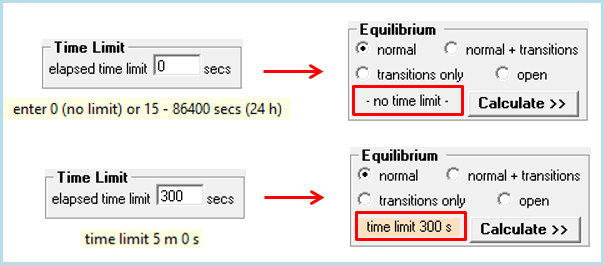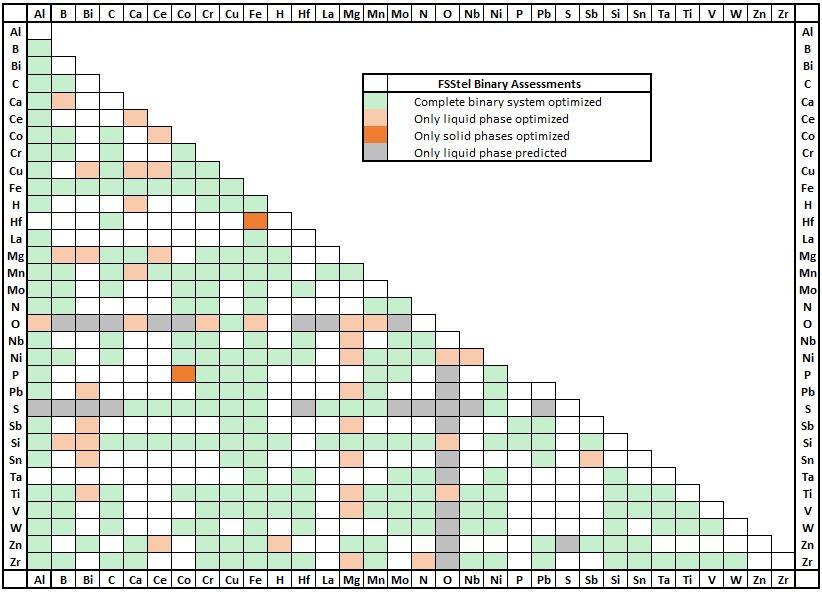1. General:
|
Important! After installation you should periodically check the latest news about FactSage 8.0 where we immediately report any 'bugs' and other issues as they surface.
You can display this latest news
- in the FactSage Main Menu click Alternatively visit www.FactSage.com > 'FactSage 8.0 ~ News ~' |
FactSage 8.0 ~ News ~ |
The 'bugs' and other issues highlighted in the previous 'FactSage 7.3 ~ News ~' have been resolved.
This option is only available to customers with FactSage ID in the range 1 - 5000
who have installed FactSage 7.3.
In order to activate this option you must first download a small file
FS-Copy_2020-06-06.zip
(approx. size 400 KB).
Replace the file FS-Copy.exe in your FactSage 7.3 installation.
Then in the FactSage 7.3 Main Menu Window click
If you are entitled to FactSage 8.0 the file CD-FactSage80.exe (approx. size 350 MB)
will be downloaded to the downloads folder.
Typically this takes 10 - 20 minutes or even longer.
2. Download via www.factsage.com
For details visit www.factsage.com
and click 'Download Service' and then 'FactSage 8.0 Update/Installation'.
FactSage dongle status
- When a valid HASP dongle is attached to a USB port on the computer you are able to run a standalone version
of FactSage.
If FactSage issues an error message about a 'missing or invalid FactSage HASP security key'
it goes into the FactSage SetUp mode with a green screen.
There are several factors that can cause this to happen.
The 'FactSage dongle status' Window shown here is for an installation where a valid FactSage dongle
is attached and everything is in order (i.e. 1 - 5. All OK).
The FactSage 8.0 Installation program enables you to update/refresh FactSage 8.0 software,
documentation and databases to the full FactSage 8.0 package.
You can update/refresh a FactSage Standalone computer or a Network
Server. In the case of a network installation it is
only necessary to update/refresh the Network Server.
For example,
Microsoft Windows Defender
may suddenly decide a particular file (for example FS-Copy.exe)
is a virus threat and delete it without notifying you.
The rules of virus detection are constantly evolving.
Even if a particular file has not been updated
a file considered safe yesterday may be classified as a threat today.
When an important file is missing you will now be made aware of the problem.
Note:
The Slide Show on the Theoretical Background of FactSage has been revised and enhanced.
An interactive Table of Contents has been added to the Slide Show.
In conjunction with this the various chapters and their respective pages have been numbered.
On the last page of each chapter a return button has been inserted to take the reader back to the
Table of Contents page.
A chapter has been added dealing with the theoretical background of EMF cell calculations.
Such calculations can be executed using the Reaction module.
The chapter on Phase Diagrams has been expanded.
Several of the side shows on FactSage Ferrous Processing and FactSage Alloy Design have been updated
and a new one on High Temperature Ceramics has been added.
This gives details on how to select a FactSage database for ferrous applications.
The slides include a history and important solution phases;
steelmaking chemistry and availability of databases;
important phase diagrams for steelmaking processes;
the Modified Quasichemical Model;
the Slag viscosity database.
The 2015 slide show has been updated.
Where necessary the text has been revised and new screenshots have been prepared to reflect the changes.
10 new sides have been introduced that include Important phases and phase diagrams: alkali-silicate system
as well as the The Quasichemical Model for Short-Range Ordering.
These give simple (I) and advanced (II) calculation examples involving
the Equilib and Phase Diagram modules in ferrous processing.
The 2015 slide shows have been updated.
Most of the calculations and plots in the 300+ slides have been repeated using FactSage 8.0.
Where necessary the text has been revised and new screenshots have been prepared to reflect the changes.
This presents the basics and the advanced approach for alloy design using FactSage.
The 2015 slide show has been updated.
All calculations and plots in the slide show have been repeated using FactSage 8.0.
Where necessary the text has been revised and new screenshots have been prepared to reflect the changes.
Particular care has been placed on the applications involving the
FTlite and FSstel databases
since their optimized data and phase names have changed extensively in the last few years.
This new slide show of over 60 pages presents a
Review of Engineering Thermodynamics and Computational Thermodynamic Databases
for High and Ultra-high Temperature Ceramics.
There are many examples of various applications such as
Refractory reactions with F containing slag/flux;
Ladle Furnace (LF) Slags;
Corrosion of Ladle purging plug by Fe oxides;
Nozzle clogging;
Carbothermic reduction of ZrO2 to ZrC;
Melting, Oxidation, Evaporation and Phase transition of Ultra High Temperature Ceramics;
Available Thermodynamic Databases;
Oxidation of ZrC-SiC-C (CMC);
Self healing CMC; TBC coating:
Cubic HfO2 and ZrO2 stabilization; etc.
If your computer has access to the Internet you can use FactSage 8.0 to download and update various
FactSage files from www.factsage.com.
Information on updates ...
- your computer has access to www.factsage.com
If you have checked
All of these actions will be done automatically.
Important - after updating the profiles file it is no longer necessary for you to quit FactSage and refresh the installation.
When you first run FactSage 8.0 the program tries to connect to www.factsage.com and check if
your installation has the latest special databases and patches.
If you have checked
The total number of stored phase diagrams has been increased by over 700.
- * are user-supplied digits 1 - 9999 or alphanumeric descriptions.
- for example, EHPH1234.dat, PREDFe-SO2-O2.dat, REACH2_plus_O2.dat, EQUIFeO-slag.dat, PHASCaO-SiO2_TvsX.dat, MIXTAir.dat
With the Windows Explorer it is difficult to manipulate the files since
one cannot order the files by type (file extension).
Options 'Save' and 'Save as ..' within the above modules are not supported by the Windows Explorer
and so it can be a challange naming or re-naming the file without access to the current list of file names.
In FactSage 8.0 the file naming convention PROG*.dat has been replaced by a more versatile *.prog.
That is, the new file names are
*.ehph, *.pred, *.reac, *.equi, *.phas and *.mixt.
For the examples above the new file names are now:
- 1234.ehph, Fe-SO2-O2.pred, H2_plus_O2.reac, FeO-slag.equi, CaO-SiO2_TvsX.phas, Air.mixt
Old PROG*.dat files will still remain accessible to the FactSage 8.0 modules.
However new user files will now have the naming convention *.prog.
That is, a folder may contain a combination of both formats say EQUI1.dat, EQUI2.dat, 3.equi and 4.equi.
In the Equilib Directory Window where you select and load stored systems these systems will appear as
Equilib Files 1, 2, 3, and 4.
If click 'File >' you can select a new option 'Rename all EQUI*.dat files as *.equi'.
In the above example you would end up with 1.equi, 2.equi, 3.equi and 4.equi.
It should be noted that the new files *.prog will not accessible to FactSage 7.3 and prior installations.
(To make a file accessible you must rename it as PROG*.dat
- see the new option in Equilib Directory Window).
For example the FactPS pure substances database
includes 91 elements.
The Equilib Slide Show - Regular Features - has been updated.
Where necessary the text has been revised and new screenshots have been prepared to reflect the changes.
Private Equilib files EQUI*.dat have been replaced by *.equi files
In FactSage 8.0 private files PROG*.dat have been replaced by *.prog files.
The macro function $EXIST() and the macro commands OPEN and SAVE
have been modified and are backward compatible it is not necessary to apply
the new naming convention to old *.mac files.
That is, you can load and run old *.mac files and not worry about the new naming convention.
$EXIST()
OPEN
SAVE
Macro example
For an example of backward compatibility run the macro EquiEx_SET_Variables.mac
located in the Macros Directory.
The macro log file posts '-------> Backward compatible: ...' each time the issue is encountered.
In FactSage 8.0 it is now possible to encrypt a macro file (*.mac) and create an encrypted macro file (*.mace).
To perform the encryption go to the Equilb Reactants Window.
2. The resulting encrypted macro file (*.mace) will be stored in the same location as the source file.
3. Note there is no option to decipher the encrypted macro.
The advantages of an encrypted macro file are:
When the macro processing is run the lines of code are displayed in real time in the Macros Window.
Use the macros command PRINTOFF to suppress the output and hide the code.
Use PRINTON to reactivate the output.
See the example below for the commands PRINTOFF and PRINTON.
The encrypted macro file (*.mace) is employed in macro processing in the same manner as a normal macro file (*.mac).
The macro functions $USERID and $USERNAME
provide the user ID (1-9999) and company name or affiliation.
Let us say you wish to give macro access only to customer ID 123 Company A-B-C.
Private Phase Diagram files PHAS*.dat have been replaced by *.phas files
- refer to Time limit - Equilib Parameters Window
In FactSage 8.0 there is a new option to automatically label the temperatures of the iso-therms on a polythermal projection.
The screenshots show the polythermal projections of the Ca-Mg-Zn ternary alloy system
and Ca-Al-N-O ternary reciprocal system taken from the stored examples -
Phase Diagram > Help > Directory of examples > Polythermal Projections ....'
The temperature labels (together with the optional units K or oC) have been plotted automatically.
They are aligned with the isothermal lines and displaced slightly to improve readability.
How the temperature labels are generated is shown next in the Manipulate and Refresh Window.
For complete details and examples click Phase Diagram Manipulate and Refresh Window.
The Phase Diagram Manipulate and Refresh Window was first introduced in FactSage 7.2,
enhanced in FactSage 7.3 and again here in FactSage 8.0.
The screenshot shows how to activate the Manipulate and Refresh Window via the Parameters Window
('Phase Diagram > Menu Window > Parameters')
In addition to the General options that apply to all diagrams,
there are now 5 categories for manipulating the calculated phase diagram:
For example, only one of 'tie lines - isothermal diagram', 'polythermal projection' or 'aqueous diagram'
could be displayed at any given time.
The screenshots below show the Manipulate and Refresh Window for a polythermal projection.
In FactSage 8.0 the effects of the options
'color', 'label iso-therms', 'label phase surfaces', 'list T(min) and T(max)',
etc. are now stored when the diagram is first calculated.
With the Manipulate and Refresh Window you then select which options you wish to apply
- the phase diagram is not recalculated but rather it is redisplayed.
This is different from FactSage 7.3 where changing the polythermal projection display options in the Parameters Windows
would necessitate a recalculation of the diagram.
In FactSage 8.0 a new component, Li2O, has been added to the viscosity databases for both Melts and Glasses.
The new lists of components are:
Al2O3-B2O3-CaO-FeO-Fe2O3-K2O-Li2O-MgO-MnO-Na2O-NiO-PbO-SiO2-TiO2-Ti2O3-ZnO-F melts
In FactSage 7.3 GTT-Technologies developed a new utility, ConvTDB,
whereby Thermo-Calc Database (TDB) format could be converted to FactSage
databases (.cdb .sln .fdb) format. ConvTDB has proved to be very useful.
Following the feedback from users ConvTDB has been updated for FactSage 8.0.
The new ConvTDB is now more reliable and robust - it is more adapt in understanding the TDB database format commands.
The error descriptions and warnings issued during the conversion process have been improved.
In addition new options that control the conversion process have been added.
Click 'Use default settings ...' to set all the options to default as displayed in the screenshot.
For complete details on the options click 'Explanation of the TDB settings ...'.
LiF, NaF, MgF2(s1), Al4C3, Na3AlF6(s1), Na3AlF6(s2), Na5Al3F14, Na2LiAlF6(s1), Na2LiAlF6(s2), CaF2(s1), CaF2(s2), LiCaAlF6, NaCaAlF6(s1), NaCaAlF6(s2), NaCaAlF6(s3), Na2Ca3Al2F14, Na4Ca4Al7F33, Li2O, MgO, CaO, Al2O3(s1), Al2O3(s2), Al2O3(s3), Al2O3(s4), NaAl9O14, CaAl12O19.
FTlite is primarily designed for thermodynamic and phase equilibrium calculations involving
Al alloys and Mg alloys.
Calculations involving Ti alloys and Li-Na-K-Mg-Ca-Sr-Ba mixtures
can also be performed but not to the extent as for Al- and Mg-alloys.
In FactSage 7.3 there was a major update and restructuring of FTlite.
Extensive and detailed Tables listing the important solutions for calculations involving Al alloys, for solutions in Mg-alloys,
and a detailed list of all solutions were given in new documentation (78 pages total!)
In FactSage 8.0 the help section dealing with the selection of phases and species has been revised.
This important information now appears near the beginning rather than at the end of the documentation file.
Minor update: - there is a correction to the volumetric properties of the Ag(fcc) pure substance
in the compound database (s1) and to the FCC_A1 phase in the solution database.
The FTsalt databases contain data for pure salts and salt solutions of 27 main cations:
and 9 main anions:
F, Cl, Br, I, NO2, NO3, OH, CO3, SO4 as well as for dilute solutions of O2- and OH- in the molten salt phase.
In FactSage 8.0 the updates to FTsalt include the following changes.
The total number of stored FTsalt phase diagrams
is now 344 (was 338 in 7.3).
Complete details on FTsalt including all the phase diagrams are given in Documentation
in the FactSage Main Menu Window.
In FactSage 8.0 the FSstel database now includes
With hydrogen (H) now included in the database, the hydrogen solubilities in liquid and solid FCC, BCC, HCP, etc. are well represented.
The updates for P and N-containing systems are done as a continuation from FSstel 7.3.
The model parameters for 18 new binary systems and 10 new ternary systems, as well as several quaternary system, are now included.
In summary, the following systems have been updated:
The total number of stored FSstel phase diagrams
is now 221 (was 198 in 7.3).
Complete details on FSstel 8.0 including all the phase diagrams are given in 'Documentation'
in the FactSage Main Menu Window.
The 79 elements included in the database are,
From among these elements, there are some 690 completely assessed binary alloy systems,
of which 92 are newly assessed systems and
many others have been revised or amended on the basis of newly published experimental information.
The database also includes about 141 ternary and 15 higher-order systems for which assessed
parameters are available for phases of practical relevance.
The systems now incorporate approximately 365 different solution phases and 1470 compound phases
(mainly stoichiometric intermetallics).
The total number of stored SGTE(2020) phase diagrams is 1299
(cf. 1176 in SGTE(2017))
Complete details on SGTE(2020) including all the phase diagrams are given in Documentation
in the FactSage Main Menu Window.
The systems incorporate approximately 67 different solution phases and 74 stoichiometric intermetallic compound phases.
In FactSage 8.0 the documentation has been revised and new diagrams have been added.
The new phase diagrams include 20 ternary systems and a large number of special isothermal sections
for which assessed parameters are available for phases of practical relevance.
The total number of stored phase diagrams is now 164 (was 55).
The elements included in SpMCBN are:
Al, Ca, Co, Cr, Fe, Hf, Mg, Mn, Mo, Nb, Ni, Re, Sc, Ta, Tc, Ti, V, W, Y, Zr
In FactSage 8.0 the database has been updated and new binary and ternary systems have been added.
The lists of the new and revised binary and ternary systems are as follows:
A spreadsheet listing all the SpMCBN 8.0 binary assessments has been prepared that
summarises the quality of the evaluations (top, good or poor).
The spreadsheet is accessible via the Documentation module:
It is also available in the View Data module:
Co-Cr-Fe, Co-Cr-Mo, Co-Cr-Ni, Co-Cr-Ta, Co-Cr-Zr, Co-Fe-Mn, Co-Fe-Mo,
Co-Fe-Nb, Co-Fe-Ni, Co-Fe-Ti, Co-Fe-Y, Co-Fe-Zr, Co-Mo-Ni, Co-Mo-W,
Co-Mo-Zr, Co-Nb-Ta, Co-Nb-W, Co-Ni-Re, Co-Ni-Ta, Co-Ni-Ti, Co-Ni-Y,
Co-Re-Y, Co-Ti-V, Co-Ti-Zr
Cr-Fe-Mn, Cr-Fe-Nb, Cr-Fe-Ti, Cr-Fe-Y, Cr-Fe-Zr, Cr-Hf-Ni, Cr-Hf-V, Cr-Hf-Zr,
Cr-Nb-Ni, Cr-Nb-V, Cr-Nb-W, Cr-Ni-Sc, Cr-Re-Ta, Cr-Re-W, Cr-Ti-V,
Cr-V-Zr, Cr-W-Zr
Fe-Hf-Y, Fe-Hf-Zr, Fe-Mo-Nb, Fe-Mo-Ta, Fe-Mo-Ti, Fe-Mo-V, Fe-Mo-Y,
Fe-Nb-Ni, Fe-Nb-Ta, Fe-Nb-Ti, Fe-Nb-W, Fe-Nb-Y, Fe-Ni-Ta, Fe-Ni-Ti,
Fe-Ni-V, Fe-Ta-W, Fe-Ta-Y, Fe-Ti-V, Fe-Ti-W, Fe-Ti-Y, Fe-W-Y,
Fe-Y-Zr
Hf-Mo-Y, Hf-Nb-Zr, Hf-Ni-Ti, Hf-Ta-V, Hf-Ta-W, Hf-Ti-Zr
Complete details on SpMCBN 8.0 including all the phase diagrams are given in
Documentation in the FactSage Main Menu.
In FactSage 8.0 the database has been updated and new binary and ternary systems have been added.
The lists of the new and revised systems are as follows:
Ba-O-Pu, Ba-Mo-O, C-Mo-U, C-O-U, C-Pu-U, Ce-Fe-O, Ce-O-Cs, Ce-O-Pu, Ce-O-U, O-Pu-U, C-Ru-U
Complete details on TDmeph including the revised documentation are given in
Documentation in the FactSage Main Menu.
It covers the entire field from metal to oxide domains.
In FactSage 8.0 the database has been updated and new binary and ternary systems have been added.
The lists of the new and revised systems are as follows:
Complete details on TDnucl including the revised documentation are given in
Documentation in the FactSage Main Menu.
What's New in:
What's New in: - if the following link is not found on your computer click on www.factsage.com
1. Download FactSage 8.0 via FactSage 7.3 - this is new
For certain installations it may not be possible to download the file - for example you may get an
error message such as 'webpage cannot be found'.
This could be because the security settings on your computer are blocking the transfer of a ".exe" file
or the file is too large to be downloaded.
Check with your IT group.
Tools > FactSage Updates >Download the complete FactSage 8.0 Update/Installation Package .
This new feature was first introduced in FactSage 7.0 and remains unchanged.
It displays the status of the FactSage dongle attached to the computer.
This helps you to diagnose the source of the error message.
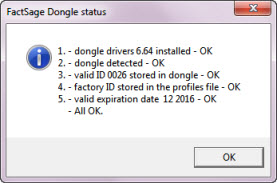

Due to some radical changes in FactSage 8.0 we recommend that you do not upgrade any FactSage 7.0 - 7.3
currently installed on your computer but rather install FactSage 8.0 as a New FactSage installation.
This is new.
Each time FactSage is run a check is now performed to make sure the important installation files (principally *.exe and *.dll)
have not been inadvertently deleted.
The *.exe and *.dll files are regularly vetted for viruses via www.virustotal.com
that has access to over 70 antivirus software.
Whenever the antivirus software reports suspicious behavior in one of our files
we try and contact the antivirus vendor and report the file as a false-positive.
- called from 'General > Slide Shows ...'.

2. Modules:
In the FactSage Main Menu click Tools > FactSage Updates
to display the following options:
- for details on the following options
- to list the files that can be updated
- to update/refresh your FactSage 8.0 expiration dates
This avoids the necessity to manually download and install an updated Profiles80.ini.
(Note, this update operation can now be done automatically - see Automatically update Profiles80.ini below).
- to update and install the latest FactSage 8.0 patches.
This avoids the necessity to manually download and install the FactSage 8.0 patches.
- the most recent FactSage 8.0 Package (CD-FactSage80.exe)
with the latest profiles file, Profiles80.ini.
- this will be available after FactSage 8.1 has been released at a future date.
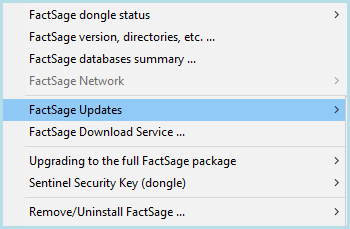
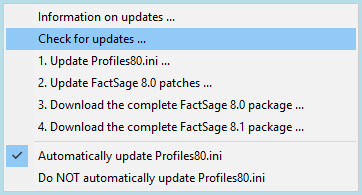
![]() Automatically update Profiles80.ini
- this option is new in FactSage 8.0
Automatically update Profiles80.ini
- this option is new in FactSage 8.0
- when necessary the latest Profiles80.ini is updated
and the FactSage 8.0 expiration dates are automatically refreshed.
Any new special database FSstel, FTlite, SpMCBN, etc. and dongle will be refreshed at the same time.
This is the recommended setting.
- in order to update Profiles80.ini you must first select
Check for updates ...
and then select 1. Update Profiles80.ini.
This setting is not recommended.
For the updating to succeed the following conditions must be satisfied:
- you are running FactSage 8.0 as a standalone or server installation i.e. not network client installation
When you first run FactSage 8.0 the program tries to connect to www.factsage.com and check if
your installation has the latest Profiles80.ini.
![]() Automatically update Profiles80.ini the latest profiles file is downloaded and installed.
In such a case you are notified that the following operations will be performed:
Automatically update Profiles80.ini the latest profiles file is downloaded and installed.
In such a case you are notified that the following operations will be performed:
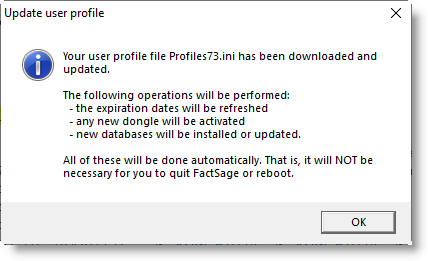
![]() Automatically update Profiles80.ini
the latest profiles file is downloaded and installed as shown above.
Automatically update Profiles80.ini
the latest profiles file is downloaded and installed as shown above.
However, if you have NOT checked
Automatically update Profiles80.ini
when necessary an 'Updates are ready.' message is posted in the FactSage Main Menu.

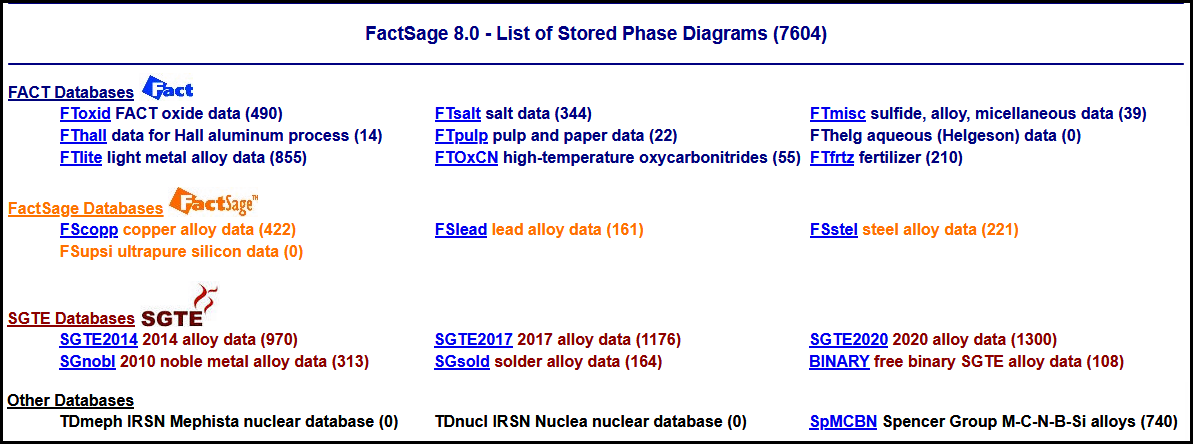
In FactSage all private files created by these modules have the naming convention PROG*.dat, where
- PROG is EHPH, PRED, REAC, EQUI, PHAS and MIXT that correspond to the modules
EhPh, Predom, Reaction, Equilib, Phase Diagram and Mixture.
In FactSage the file extension *.dat is not limited to the modules above.
For example, ChemSage files also employ the same file extension.
The link What's New in View Data has been updated and
gives a summary of the more important programming changes in View Data that have appeared
since FactSage 6.1 (2009) until now FactSage 8.0 (2020).
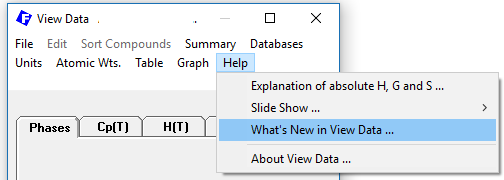
The summary of data for compounds now includes the total number of components (elements).

The link What's New in Equilib has been updated
and gives a summary of the more important programming changes in Equilib that have appeared
since FactSage 6.1 (2009) until now FactSage 8.0 (2020).
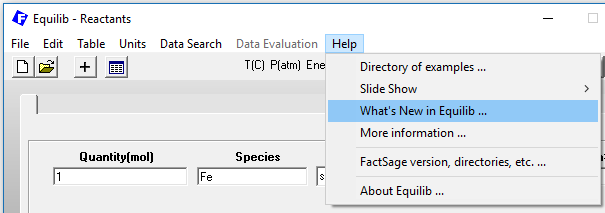
- for details refer to
New file structure
The link What's New in Macro Processing has been updated
and gives a summary of the more important programming changes in Macro Processing
that have appeared since FactSage 5.5 (2007) until now FactSage 8.0 (2020) .

$EXIST('FileName') // = 1 if 'FileName' exists
$EXIST(EQUIEx_CH4-O2.dat) // FactSage 7.3 (and prior) naming convention
$EXIST(Ex_CH4-O2.equi) // FactSage 8.0 naming convention
The macro function $EXIST is backward compatible.
For example, $EXIST(EQUIEx_CH4-O2.dat) returns a value 1 if the file Ex_CH4-O2.equi exists.
OPEN 'FileName' // open (load) Equilib and Phase Diagram files
OPEN EQUIEx_CH4-O2.dat // FactSage 7.3 (and prior) naming convention
OPEN Ex_CH4-O2.equi // FactSage 8.0 naming convention
The macro command OPEN is backward compatible.
For example the command OPEN EQUIEx_CH4-O2.dat
opens the file Ex_CH4-O2.equi if it exists.
SAVE 'Mixture' GAS (LIQUIDS SOLIDS SOLUTIONS 'phase-name') // save results in a stream
SAVE MIXTMyGas.dat GAS // FactSage 7.3 (and prior) naming convention
SAVE MyGas.mixt GAS // FactSage 8.0 naming convention
The macro command SAVE 'Mixture' is backward compatible.
For example SAVE MIXTMyGas.dat saves the mixture in MyGas.mixt.
1. Click 'File > Macro processing ... > Encrypt macro ...'
and open the macro file (*.mac) you wish to encrypt.
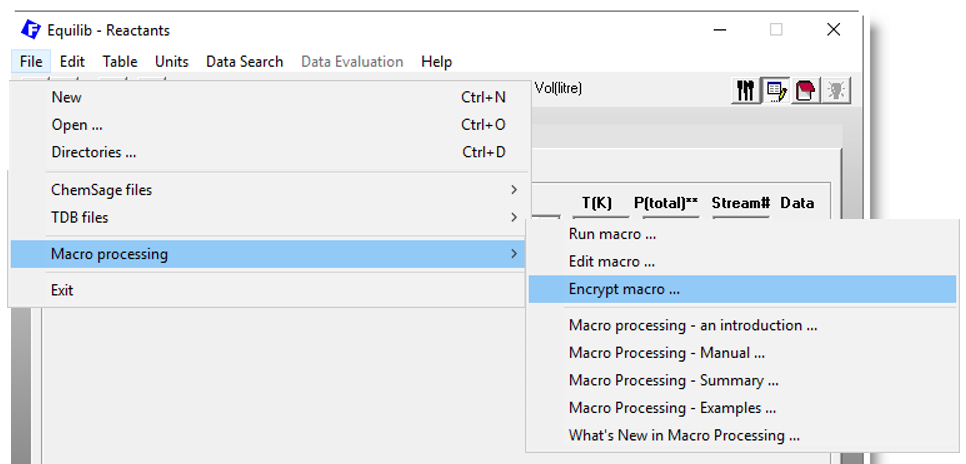
The encrypted file cannot be modified or edited.
Any attempts to do so render the file corrupt and useless.
The contents of the original macro source file are hidden.
Insert the following commands into the macro file.
To permit access to only IDs 123, 456 and 789 use:
DIM %ID %NAME
%ID = $USERID
%NAME = $USERNAME
PRINTOFF // The following lines will NOT appear in the Macros Window.
IF %ID <> 123 THEN // i.e. if ID is not 123
%TITLE = User ID %ID %NAME
MSGBOX Access limited to ID 123 - Company ABC
GOTO END // terminate the macro processing
ENDIF
PRINTON // The following lines will appear in the Macros Window.
...
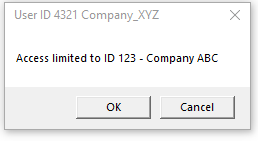
IF %ID <> 123 AND %ID <> 456 AND %ID <> 789 THEN
To block access to all except IDs 200 - 300 use:
IF %ID < 200 OR %ID > 300 THEN
When finished remember to encrypt the macro file.
The link What's New in Phase Diagram has been updated and
gives a summary of the more important programming changes in
Phase Diagram that have appeared since FactSage 6.1 (2009) until now FactSage 8.0 (2020).
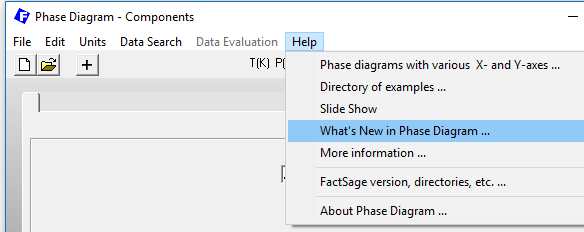
- for details refer to
New file structure

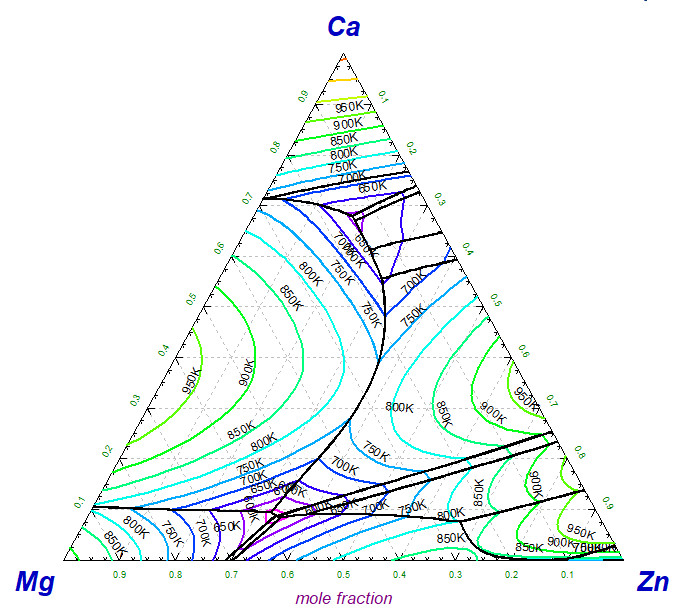
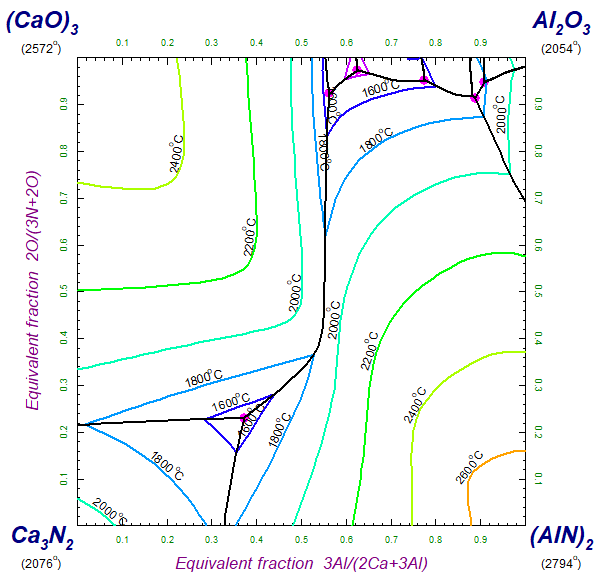
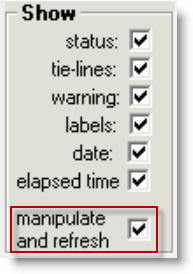
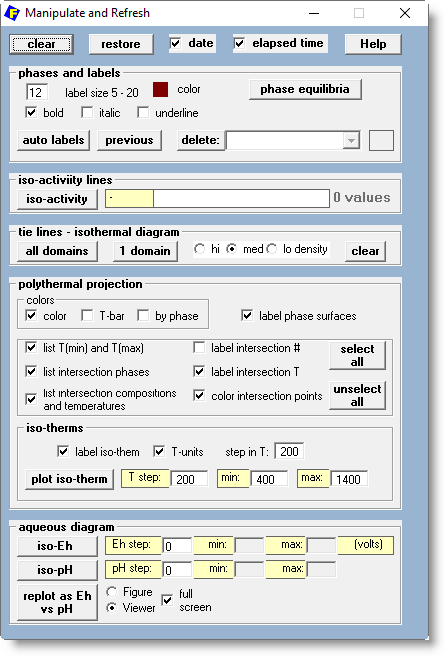
The screenshot shows all 5 categories but in actual calculations only 'phases and labels'
is displayed together with the other pertinent option.
- click 'unselect all'.
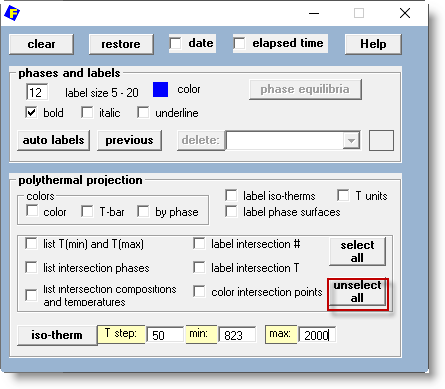
- click 'select all' - as well as the labels.
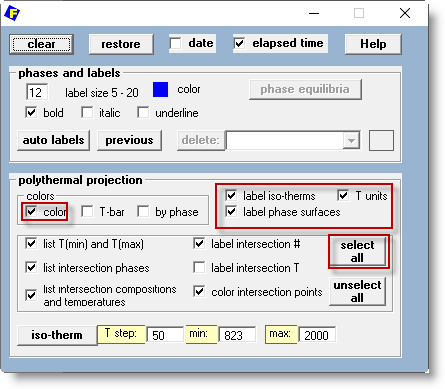
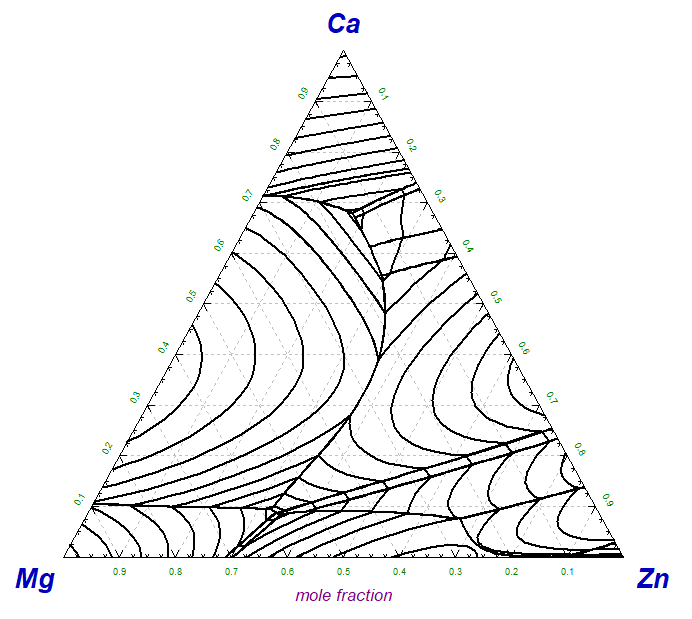
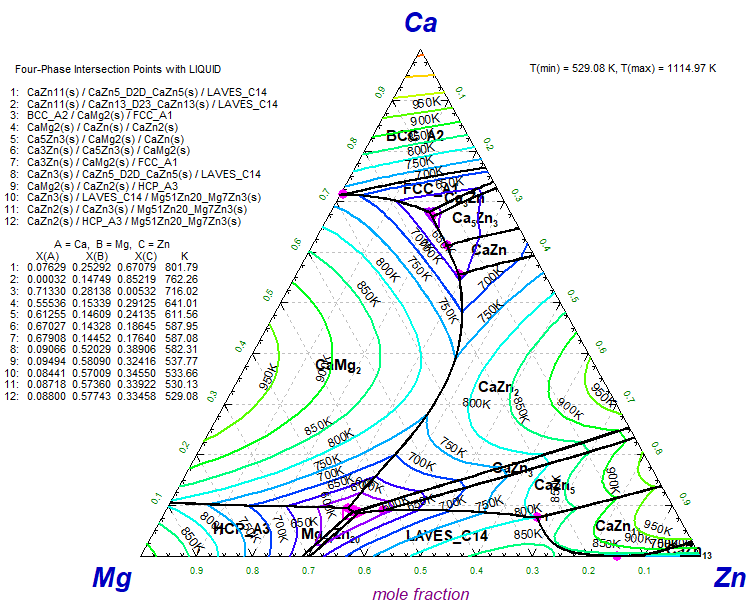
For more details and examples click Phase Diagram Manipulate and Refresh Window.
The Viscosity module calculates the viscosity of single-phase liquid slags (melts) and liquid glasses.
and
Al2O3-B2O3-CaO-K2O-Li2O-MgO-Na2O-PbO-SiO2 glasses.
In the FactSage Main Menu Window click Documentation for detailed information on the public compound and solution databases.
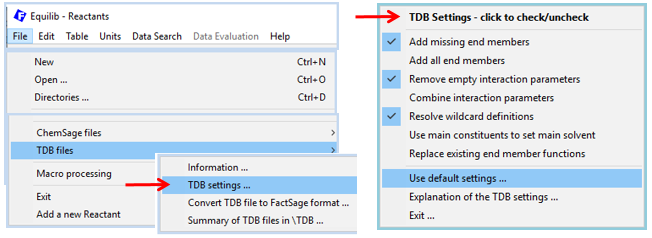
You click the appropriate option in order to check/uncheck its setting .
Al2O3 (S1, S2, S3, S4)
Al2Si2O7
BaO
Ca2Al2SiO7
Ca2Fe2O5
Ca2SiO4 (S1, S2, S3)
Ca3Al2O6
Ca3MgSi2O8
Ca3Si2O7
Ca3SiO5
CaAl12O19
CaAl2O4
CaAl2Si2O8 (S1, S2)
CaAl4O7
CaCr2O4 (S1, S2)
CaFe2O4
CaMgSi2O6
CaO
CaSiO3 (S1, S2)
CaTiO3 (S1, S2)
CaZrO3 (S1, S2)
CoO
Cr2MgO4
Cr2O3
Cu2O
Fe2O3 (S1, S2, S3)
Fe2SiO4 (S1, S2, S3)
FeTi2O5
KAl9O14
KAlSi2O6 (S1, S2)
KAlSi3O8 (S1, S2, S3)
KAlSiO4 (S1, S2)
Mg2Al4Si5O18
Mg2SiO4 (S1, S2, S3)
Mg3Al2Si3O12
MgO
MgSiO3 (S1, S2, S3, S4, S5, S6, S7)
MnO
NaAl9O14
NaAlSi2O6
NaAlSi3O8 (S1, S2)
NaAlSiO4 (S1, S2)
NiO
SiO2 (S1, S2, S3, S4, S5, S6, S7, S8)
SnO2
Ti2O3 (S1, S2)
TiO2 (S1, S2)
Zn2SiO4
ZnO
ZrO2 (S1, S2, S3)
ZrSiO4
Ca2ZrSi4O12
Ca3ZrSi2O9
Ca6Zr19O44
CoAs
CoAs2
FeAs
H3AsO3(Aq)
K10Mg5Si11O32
K2Ca2Si2O7
K2Ca2Si9O21
K2Ca3Si6O16
K2Ca6Si4O15
K2CaSiO4
K2Mg5Si12O30
K2MgSi3O8
K2MgSi5O12
K2MgSiO4
K3PO4
K4CaSi3O9
K4CaSi6O15
K4Mg2Si5O14
K4P2O7
K5P3O10
K8CaSi10O25
KH2AsO4
KNO2
KPO3
Li2Ca2Si2O7
Li2Ca3Si6O16
Li2Ca4Si4O13
Li2CaSiO4
Li5AlO4
LiAl11O17
LiAl5O8
LiAl7O11
Na2(NO3)(NO2)
NaAs
NaAs2
K2Cl(NO3)
K2OH(NO3)
KNO3
Li2O
Li2O2
Na2OH(NO3)
Na3(OH)2(NO3)
NaNO2
NaNO3
NaRb3(NO3)4
The FThall database contains the elements Al-Mg-Na-Li-Ca-F-O-C.
It is used for thermodynamic and phase equilibrium calculations involving liquid metal - cryolitic bath -
Al2O3-based oxides in alumina reduction electrolysis cells, and for molten aluminum treatment with fluoride fluxes.

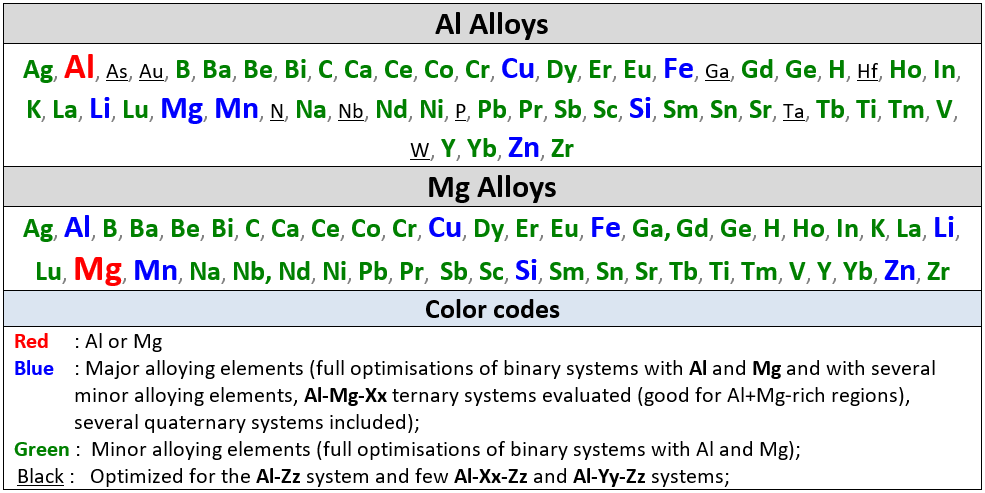
Li, Na, K, Rb, Cs, Mg, Ca, Sr, Ba, Mn, Al, Fe(II), Fe(III), Co, Ni, Zn, Pb, La, Ce, Th,
U(III), U(IV), Pu(III), Pu(IV), Cr(II), Cr(III), Mo(V)
Minor update: - there is a correction to the volumetric properties of the Ag(fcc) pure substance
in the compound database (s1) and to the FCC_A1 phase in the solution database.
Minor update: - there is a correction to the volumetric properties of the Ag(fcc) pure substance
in the compound database (s1) and to the FCC_A1 phase in the solution database.
FSstel covers a wide range of commercial grade carbon steels and stainless steels, and new high advanced steels under development.
With the addition of hydrogen (H) the database now contains 32 elements:
Al, B, Bi, C, Ca, Ce, Co, Cr, Cu, Fe, H, Hf, La, Mg, Mn, Mo,
N, O, Nb, Ni, P, Pb, S, Sb, Si, Sn, Ta, Ti, V, W, Zn, Zr
Binaries: Al-P, Cr-P, Fe-P, Mn-P, Ni-P, Si-P
Ternaries: Fe-Mn-P, Al-Fe-P, Fe-Si-P, C-Fe-P, Cr-Fe-P, Fe-Ni-P
Binaries: Al-N, C-N, Si-N
Ternaries: Al-Fe-N, C-Fe-N, C-N-Si, Fe-N-Si, Mn-N-Si, Fe-Mn-N, Fe-N-P
Quaternaries: Al-Fe-N-Si, many quaternary systems with liquid only
Higher order system: Al-C-Fe-Mn-N-Si
Binaries: Al-Co (FCC is slightly changed)
Ternaries: Al-Co-Ni, Al-Cr-Ni, Al-Cr-Ti, Co-Cr-Ni, Co-Ni-Ti
The SGTE(2020) database represents a significant update and revision of the previous SGTE(2017) alloy database.
Ag, Al, Am, As, Au, B, Ba, Be, Bi, C, Ca, Cd, Ce, Co, Cr, Cs, Cu, Dy, Er, Eu, Fe, Ga, Gd, Ge, H, Hf, Hg, Ho, In, Ir, K, La, Li, Lu, Mg, Mn, Mo, N, Na, Nb, Nd, Ni, Np, O, Os, P, Pa, Pb, Pd, Pr, Pt, Pu, Rb, Re, Rh, Ru, S, Sb, Sc, Se, Si, Sm, Sn, Sr, Ta, Tb, Tc, Te, Th, Ti, Tl, Tm, U, V, W, Y, Yb, Zn, Zr
The SGsold alloy phase database 2009 includes 11 elements:
Ag, Au, Bi, Cu, In, Ni, Pb, Pd, Sb, Sn, Zn
SpMCBN contains assessed thermodynamic parameters for binary and ternary alloys of high-temperature materials containing carbon, nitrogen, boron, and silicon. The alloys comprise the following systems:
Me1-Me2-C, Me1-Me2-N, Me1-Me2-B, Me1-Me2-Si, Me-C-N, Me-C-B, Me-C-Si, Me-N-B, Me-N-Si, Me-B-Si, Me1-Me2-Me3
B, C, N, Si with
Co-Nb, Co-Zr, Fe-Hf, Fe-Nb, Fe-Re, Fe-Tc, Ni-Ta, Re-W
'Documentation > [SpMCBN] > Spreadsheet of binary assessments ...'
'View Data > Data compound > SpMCBN > Elements: ALL > Assessments ...'
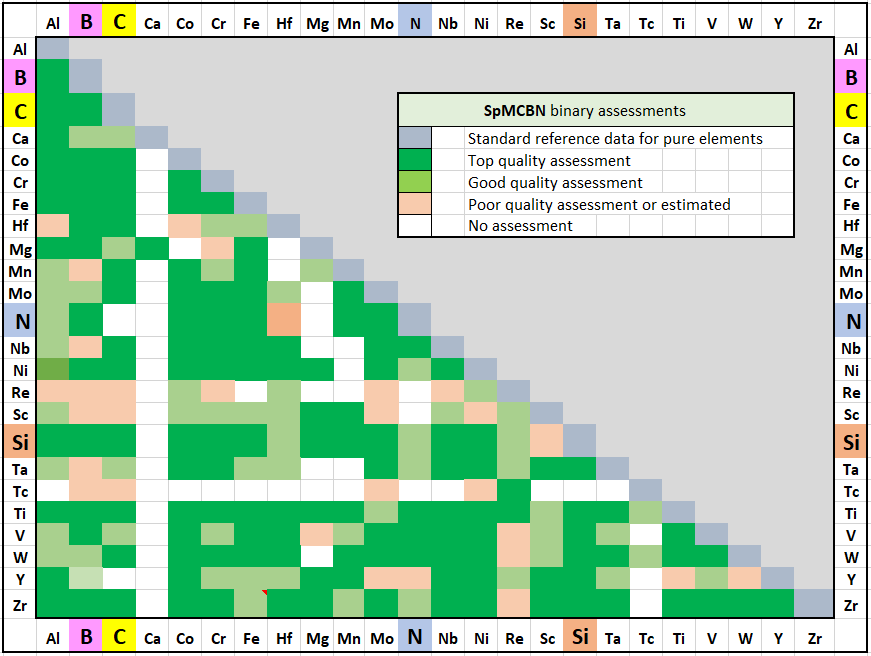
Al-Fe-Mn
The total number of stored SpMCBN phase diagrams is now 740 (cf. 664 in 7.3)
TDmeph is a special database developed for new generation nuclear fuels containing the following 14+2 elements:
O, U, Pu, Zn, Fe, Si, C, Ba, Ce, Cs, La, Mo, Ru, Sr + Ar, H.
Ba-Ce, C-Ce, C-Cs, C-Pu, C-Sr, C-U , Ce-Cs, Ce-Fe, Ce-La, Ce-Mo, Ce-O, Ce-Pu, Ce-Ru, Ce-Si, Ce-Sr, Ce-U, Ce-Zr, La-Ru, Mo-O, Mo-Pu, O-Pu, Ru-U
BaO-CeO2, BaO-ZrO2, CeO2-La2O3, CeO2-SrO, Ce2O3-MoO3, Ce2O3-SiO2, CeO2-ZrO2, Ce2O3-ZrO2, La2O3-ZrO2, PuO2-ZrO2, PuO2-UO2
Ce-O-Pu, Fe-O-Pu, La-O-Pu, Mo-O-Pu, O-Pu-Si, O-Pu-Sr, O-Pu-Zr, C-O-Pu
TDNucl contains the following 18+2 elements:
O, U, Zr, Ag, In, B, C, Fe, Cr, Ni, Ba, La, Sr, Ru, Al, Ca, Mg, Si + Ar, H
Ag-Al, Ag-B, Ag-C, Al-Ca, Al-Cr, Al-In, Al-Zr, B-C, B-La, B-Ru, C-Ca, C-Cr, C-Mg, C-Ni, C-Sr, C-U, Ca-Mg, Cr-La, Cr-O, In-Zr, La-Ni, La-Ru, Ni-Sr, Ni-Zr, O-U, Ru-U
Al2O3-CaO, BaO-ZrO2, La2O3-ZrO2
Al-O-Fe, C-O-U, Ca-Cr-O, Cr-O-Si, Ni-O-Si
Al2O3-CaO-MgO, Al2O3-MgO-SiO2, CaO-FeO-Fe2O3, CaO-MgO-SiO2, SiO2-FeO-Fe2O3
Al-Ca-Fe-O, Al-Fe-O-Si, Ca-Cr-O-Si
Screenshot showing the summary of public databases in FactSage 8.0.
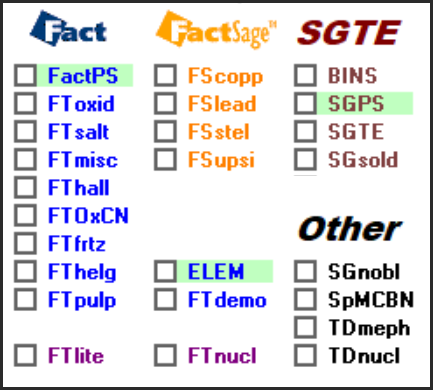
4. Previous FactSage Versions
The following are summaries of the more important programming changes in
Equilib, Phase Diagram, Macro Processing and Databases that have appeared in
FactSage 6.1 (2009), FactSage 6.2 (2010), FactSage 6.3 (2012), FactSage 6.4 (2013),
FactSage 7.0 (2015), FactSage 7.1 (2017), FactSage 7.2 (2018) , FactSage 7.3 (2019) and FactSage 8.0 (2020).
The following are summaries of the more important programming changes in each release.
